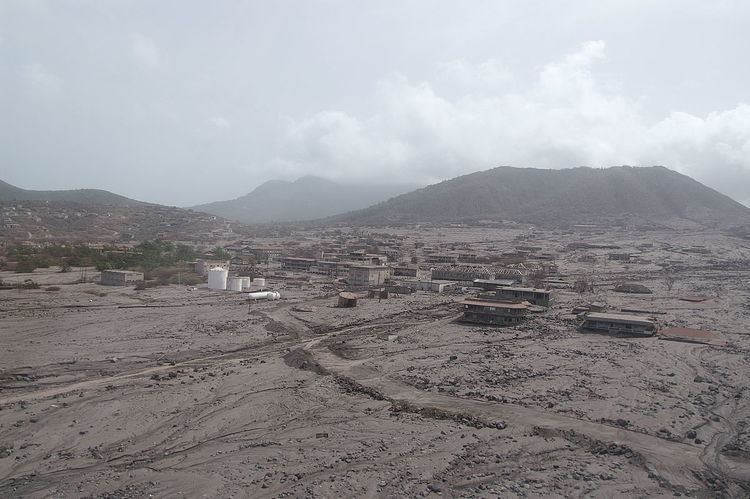Time zone Atlantic (UTC-4) Local time Wednesday 2:15 AM | Population 1,478 (1980) Number of airports 1 | |
 | ||
Weather 24°C, Wind E at 19 km/h, 85% Humidity | ||
Plymouth was the capital of the island of Montserrat, an overseas territory of the United Kingdom located in the Leeward Island chain of the Lesser Antilles, West Indies. Constructed on historical lava deposits near the then inactive Soufriere Hills volcano, the town was evacuated when the volcano resumed erupting in 1995, and was abandoned permanently in 1997 after it was burnt and mostly buried by a series of pyroclastic flows and lahars. For centuries it had been the only port of entry to the island.
Contents
Map of Plymouth, Montserrat
Plymouth is still the de jure capital of Montserrat, making it the only ghost town which is the capital of a political territory.
Volcano and abandonment
Beginning in July 1995, a series of huge eruptions at the Soufrière Hills volcano sent pyroclastic flows and ash falls across a wide area of southern Montserrat including the capital, Plymouth. It was immediately clear that the town was in grave danger; on 21 August 1995, tephra fell on Plymouth, and in December residents were evacuated as a precaution. Residents were allowed back a few months later but on 25 June 1997, a massive eruption produced pyroclastic surges that killed 19 people and reached nearly to the island's airport on the eastern side of the island. Plymouth was again evacuated.
Between 4–8 August a further series of large eruptions destroyed approximately 80 percent of the town, burying it under 1.4 metres (4.6 ft) of ash. This hot material burned many of the buildings, making inhabitation nearly impossible for a sizable portion of the residents.
The pyroclastic flows, lava, ash and other volcanic rock types were mostly compact, having a density similar to that of concrete. The removal of the overburden would have required the use of explosives, bulldozers and other resources too expensive for widespread use. Furthermore, it was anticipated that the soil underneath the hardened mud and lava would have been scorched and left completely non-arable by the heat of the pyroclastic flows. Plymouth was abandoned and the entire southern half of the island was declared an exclusion zone because of the continuing volcanic activity at the Soufrière Hills. The government of the island was moved to Brades, although Plymouth remains the de jure capital. As of 2013, a new port and capital are under construction at Little Bay, on the island's northwest coast.
The destruction of Plymouth caused severe economic problems for the island of Montserrat. Plymouth had been by far the largest settlement on the island, with around 4,000 inhabitants. It had been the site of almost all the island's shops and services, in addition to having been its seat of government. Some of the lost facilities were subsequently rebuilt elsewhere on Montserrat, but this did not prevent emigration. The island was evacuated of more than two-thirds of its population. Most of the evacuees, having gone to the UK, have not returned to the island.
